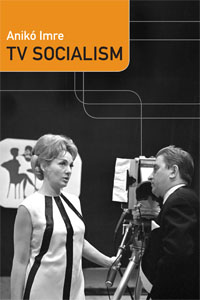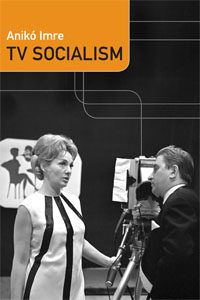

This is part of our special feature, Diversity, Security, Mobility: Challenges for Eastern Europe.
The past few years have seen a speedy rise in the volume of original research and scholarly recognition regarding socialist television. Anikò Imre’s TV Socialism arrived just when media researchers and social historians regained interest in the socialist everyday life of Eastern Europeans. In her book, Imre raises the question: “What do we learn about socialism when we examine it through the medium of television?” She extends her research focus by considering the television genres that occurred under socialism and that can still be found in post-socialist societies. Imre tries to decipher and follow specific patterns within the adaptations of socialist TV genres following Western role models within the field, always contesting the binaries of the Cold War that have structure most research on east European arts and media. Still, it would have been nice to get a broader overview of television history of former Warsaw Pact member states and their contribution to TV history. The latter project would be unlikely to fulfill in an adequate mode, bearing in mind that the investigation of television and popular media in this huge region has only just moved into the focus of research, and archival materials have yet to be explored entirely. Imre’s biggest merit is opening a window into a long-gone era using television as an exemplary object to carry out research that offers new insights, presumably because Imre recognized that “television’s lower cultural status often allowed it to go under the radar of censorship” (Imre 2016: 9).
The book is organized around twelve chapters on genres of realism and reality, genres of history, genres of fiction, and finally on genres of humor. Genre, in this case, is understood as “a trans-cultural form of expression rather than a set of specific television genres, since socialist genres do not exactly overlap with those derived from Anglo-American television.” Additionally, it engages with these categories based on a selection of key concepts such as: competition, nostalgia, gender, and (post)feminism. Imre’s thoughts on these ideas extend former studies because they blend contemporary patterns imminent to socialist societies with continuities in the post-socialist era in a very satisfying way.
The volume offers a mesmerizing gaze on the television industry behind the iron curtain, providing television scholars, who have ignored Soviet and Soviet bloc television, an opportunity to learn about an industry and culture that, as Imre systematically outlines, was much more similar to Western models of television than usually acknowledged. The detailed research including interviews and case studies of key programs demonstrates how Soviet television influenced Western television and is still relevant today with genres like reality TV. She looks at the variety of genres of “socialism TV” and discusses how these genres content and production varied from one nation to another behind the “iron curtain.” The concluding chapters on the idea of satire and “fake news” in the Soviet system feels especially relevant with the rise of channels like Comedy Central and the impact of “fake news” in recent political debates.
Chapter Seven, on television and nostalgia, seems to be the most important one. The ideas and explanations on the importance of television as a didactic tool to history seem to be non-negotiable, as “[televison] is a primary generator of collective memory.” For most people, television is a window towards past epochs and we definitely have to take in account that scholars have to offer a tool kit to understand the mechanisms of how history is mediated. Imre offers an understanding of the two major terms in that field of research: “history” and “memory” and also demonstrates how often these terms are mixed and misused within academic and public discourse. When it comes to nostalgia, Imre argues that the roots of nostalgia and nationalism can be traced back to the history of Central and Eastern Europe and are inevitably part of national Television. She also puts a finger on what is called Ostalgia, a form of nationalism that appears to offer belittlement of East German history behind the iron curtain and is usually a white wash of political hardness and socialist downfall.
Reading the book, I found myself wanting to see a lot of the programs Imre was writing about and rethinking my own understanding of television as a global medium. Myfavorite chapter is the final one on Socialist Comedy, for it presents a lot of observation of socialist everyday. The chapter shows the different modes of coping with the hardship of socialist regimes and how humor is a global key to overcome these conditions. The final message and the main approach seem to be absolutely congruent, when Imre argues that Television is key to understanding European socialist cultures and to making sense of developments after the end of the Cold War and the enduring global legacy of socialism. A logical extension of Imre’s research would be a more decidedly political economy and a somehow critical social perspective on the whole television industry. Still, one might criticize the small number of case studies building the base of the book but Imre manages it to focus on the key ideas while using genre as her personal focus. Regardless, Imre keeps on fascinating the reader with examples of socialist everyday that one would not expect, such as the socialist commercials which Imre describes as “Time-Space Machines.”
Overall, TV Socialism is a very fine and well written piece of research, definitely worth a read for everyone attracted by Eastern European popular culture. It offers a wonderful and always entertaining journey into the realm of socialist television, and by doing so, a journey into an audio-visual world of the past. It is a must read for anyone who is doing research in the field of television history, socialist history, not to forget those intrigued by insights into everyday socialist life.
Reviewed by Stefan Zimmermann, Göttingen
TV Socialism
by Anikó Imre
Publisher: Duke University Press
Hardcover / 315 pages / 2016
ISBN: 978-0-8223-6085-8
To read more book reviews, please click here.
Published on December 6, 2017.




